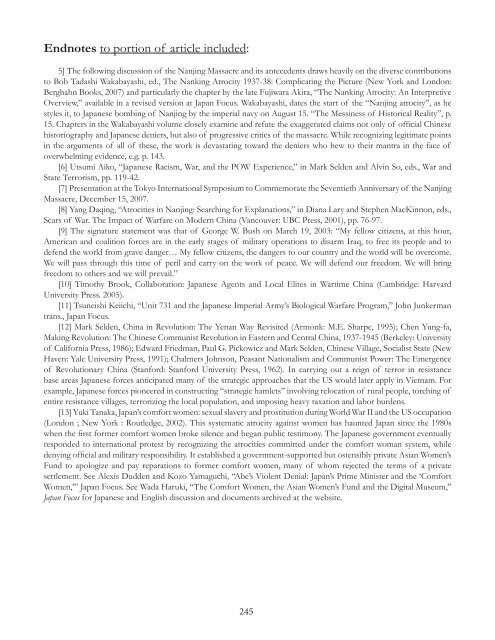Download - Canada ALPHA
Download - Canada ALPHA
Download - Canada ALPHA
Create successful ePaper yourself
Turn your PDF publications into a flip-book with our unique Google optimized e-Paper software.
Endnotes to portion of article included:<br />
5] The following discussion of the Nanjing Massacre and its antecedents draws heavily on the diverse contributions<br />
to Bob Tadashi Wakabayashi, ed., The Nanking Atrocity 1937-38: Complicating the Picture (New York and London:<br />
Berghahn Books, 2007) and particularly the chapter by the late Fujiwara Akira, “The Nanking Atrocity: An Interpretive<br />
Overview,” available in a revised version at Japan Focus. Wakabayashi, dates the start of the “Nanjing atrocity”, as he<br />
styles it, to Japanese bombing of Nanjing by the imperial navy on August 15. “The Messiness of Historical Reality”, p.<br />
15. Chapters in the Wakabayashi volume closely examine and refute the exaggerated claims not only of offi cial Chinese<br />
historiography and Japanese deniers, but also of progressive critics of the massacre. While recognizing legitimate points<br />
in the arguments of all of these, the work is devastating toward the deniers who hew to their mantra in the face of<br />
overwhelming evidence, e.g. p. 143.<br />
[6] Utsumi Aiko, “Japanese Racism, War, and the POW Experience,” in Mark Selden and Alvin So, eds., War and<br />
State Terrorism, pp. 119-42.<br />
[7] Presentation at the Tokyo International Symposium to Commemorate the Seventieth Anniversary of the Nanjing<br />
Massacre, December 15, 2007.<br />
[8] Yang Daqing, “Atrocities in Nanjing: Searching for Explanations,” in Diana Lary and Stephen MacKinnon, eds.,<br />
Scars of War. The Impact of Warfare on Modern China (Vancouver: UBC Press, 2001), pp. 76-97.<br />
[9] The signature statement was that of George W. Bush on March 19, 2003: “My fellow citizens, at this hour,<br />
American and coalition forces are in the early stages of military operations to disarm Iraq, to free its people and to<br />
defend the world from grave danger… My fellow citizens, the dangers to our country and the world will be overcome.<br />
We will pass through this time of peril and carry on the work of peace. We will defend our freedom. We will bring<br />
freedom to others and we will prevail.”<br />
[10] Timothy Brook, Collaboration: Japanese Agents and Local Elites in Wartime China (Cambridge: Harvard<br />
University Press. 2005).<br />
[11] Tsuneishi Keiichi, “Unit 731 and the Japanese Imperial Army’s Biological Warfare Program,” John Junkerman<br />
trans., Japan Focus.<br />
[12] Mark Selden, China in Revolution: The Yenan Way Revisited (Armonk: M.E. Sharpe, 1995); Chen Yung-fa,<br />
Making Revolution: The Chinese Communist Revolution in Eastern and Central China, 1937-1945 (Berkeley: University<br />
of California Press, 1986); Edward Friedman, Paul G. Pickowicz and Mark Selden, Chinese Village, Socialist State (New<br />
Haven: Yale University Press, 1991); Chalmers Johnson, Peasant Nationalism and Communist Power: The Emergence<br />
of Revolutionary China (Stanford: Stanford University Press, 1962). In carrying out a reign of terror in resistance<br />
base areas Japanese forces anticipated many of the strategic approaches that the US would later apply in Vietnam. For<br />
example, Japanese forces pioneered in constructing “strategic hamlets” involving relocation of rural people, torching of<br />
entire resistance villages, terrorizing the local population, and imposing heavy taxation and labor burdens.<br />
[13] Yuki Tanaka, Japan’s comfort women: sexual slavery and prostitution during World War II and the US occupation<br />
(London ; New York : Routledge, 2002). This systematic atrocity against women has haunted Japan since the 1980s<br />
when the fi rst former comfort women broke silence and began public testimony. The Japanese government eventually<br />
responded to international protest by recognizing the atrocities committed under the comfort woman system, while<br />
denying offi cial and military responsibility. It established a government-supported but ostensibly private Asian Women’s<br />
Fund to apologize and pay reparations to former comfort women, many of whom rejected the terms of a private<br />
settlement. See Alexis Dudden and Kozo Yamaguchi, “Abe’s Violent Denial: Japan’s Prime Minister and the ‘Comfort<br />
Women,’” Japan Focus. See Wada Haruki, “The Comfort Women, the Asian Women’s Fund and the Digital Museum,”<br />
Japan Focus for Japanese and English discussion and documents archived at the website.<br />
245


